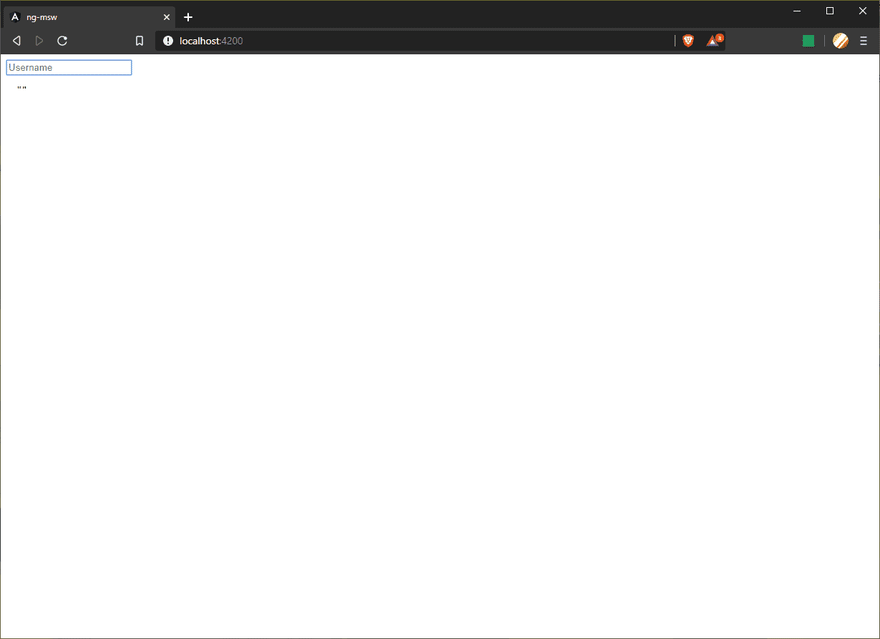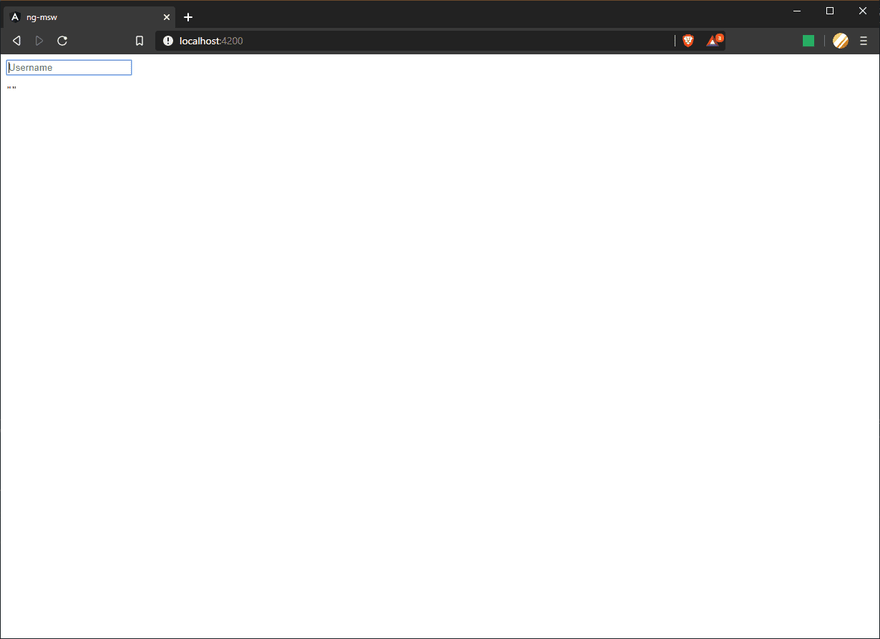Follow me on Twitter at @tim_deschryver | Subscribe to the Newsletter | Originally published on timdeschryver.dev.
During the past weeks, I've seen posts around the library MSW (MockServiceWorker).
Seamless REST/GraphQL API mocking library for browser and Node.
MSW seems to gain some popularity fast, and most of it is coming from the React community.
It even became the recommended approach to mock HTTP requests with React Testing Library.
Kent C. Dodds wrote a blog post "Stop mocking fetch" in which he explains what problems MSW can resolve. If you're not familiar with MSW, I would suggest skimming through the documentation or to read Kent's blog before continuing.
Because it receives a lot of positive feedback I wanted to give this a shot with Angular.
In this post, we'll create a proof of concept to search a GitHub user for a username.
The implementation of the Angular service, looks as this:
@Injectable({
providedIn: 'root',
})
export class GitHubService {
constructor(private http: HttpClient) {}
getUser(username: string) {
return this.http.get(`https://api.github.com/users/${username}`)
}
}
If you want to test a component using the GitHubService, typically a mocked service instance is provided.
it('should search on username', async () => {
await render(AppComponent, {
imports: [HttpClientModule, ReactiveFormsModule],
providers: [
{
provide: GitHubService,
useValue: {
getUser: () => of({ user: 'provided-user' }),
},
},
],
})
await userEvent.type(screen.getByRole('searchbox'), 'timdeschryver')
await screen.findByText(/provided-user/i)
})
Setup
The first step is to install MSW with the following command.
This will create the ./src/mockServiceWorker.js file which includes the Service Worker.
npx msw init src
To be able to serve the service worker, add it to the assets inside the angular.json file.
With this step, the mockServiceWorker.js file will be copied over to the build output.
{
"build": {
"builder": "@angular-devkit/build-angular:browser",
"options": {
"outputPath": "dist/ng-msw",
"index": "src/index.html",
"main": "src/main.ts",
"polyfills": "src/polyfills.ts",
"tsConfig": "tsconfig.app.json",
"aot": true,
"assets": ["src/favicon.ico", "src/assets", "src/mockServiceWorker.js"],
"styles": ["src/styles.css"],
"scripts": []
}
}
}
That's all for the configuration, now it's time to create the mocked server.
import { setupWorker, rest } from 'msw'
export const mocks = [
rest.get('https://api.github.com/users/:user', (req, res, ctx) => {
const { user } = req.params
return res(
ctx.status(200),
ctx.json({
name: `mocked-${user}`,
bio: 'mocked-bio',
}),
)
}),
]
const worker = setupWorker(...mocks)
worker.start()
export { worker, rest }
The last part is to import the mock.
Here, we use a dynamic import so it's only included in a non-production build.
import { enableProdMode } from '@angular/core'
import { platformBrowserDynamic } from '@angular/platform-browser-dynamic'
import { AppModule } from './app/app.module'
import { environment } from './environments/environment'
if (environment.production) {
enableProdMode()
} else {
import('./mocks/browser')
}
platformBrowserDynamic()
.bootstrapModule(AppModule)
.catch(err => console.error(err))
This gives us the following result.
Karma/Jasmine Tests
Because Angular uses a different builder during tests, we also need to add the mockServiceWorker to the test builder.
{
"test": {
"builder": "@angular-devkit/build-angular:karma",
"options": {
"main": "src/setupKarma.ts",
"polyfills": "src/polyfills.ts",
"tsConfig": "tsconfig.spec.json",
"karmaConfig": "karma.conf.js",
"assets": ["src/favicon.ico", "src/assets", "src/mockServiceWorker.js"],
"styles": ["src/styles.css"],
"scripts": []
}
}
}
Just like when the application is served, the mock server needs to be imported to register the service worker.
We import the mocks in the ./src/test.ts file where the test environment is created, so it's available for all tests.
// This file is required by karma.conf.js and loads recursively all the .spec and framework files
import 'zone.js/dist/zone-testing'
import { getTestBed } from '@angular/core/testing'
import {
BrowserDynamicTestingModule,
platformBrowserDynamicTesting,
} from '@angular/platform-browser-dynamic/testing'
import './mocks/browser'
declare const require: {
context(
path: string,
deep?: boolean,
filter?: RegExp,
): {
keys(): string[]
<T>(id: string): T
}
}
// First, initialize the Angular testing environment.
getTestBed().initTestEnvironment(
BrowserDynamicTestingModule,
platformBrowserDynamicTesting(),
)
// Then we find all the tests.
const context = require.context('./', true, /\.spec\.ts$/)
// And load the modules.
context.keys().map(context)
Now, we can simply write the test without having to provide a mocked instance of the service.
import { HttpClientModule } from '@angular/common/http'
import { ReactiveFormsModule } from '@angular/forms'
import { render, screen } from '@testing-library/angular'
import userEvent from '@testing-library/user-event'
import { AppComponent } from './app.component'
it('should search on username', async () => {
await render(AppComponent, {
imports: [HttpClientModule, ReactiveFormsModule],
})
await userEvent.type(
screen.getByPlaceholderText(/Username/i),
'timdeschryver',
)
await screen.findByText(/mocked-timdeschryver/i)
})
Jest Tests
For Jest, we can't use the current setup.
Don't worry, the mocks are reused but because Jest runs in a Node environment, the worker can't be.
⚠ While I think the following should work, it seems like the request doesn't resolve correctly and Angular doesn't receive the response.
To reuse the mocks, move it to another file so it's possible to share the setup between a browser environment and a Node environment.
export const createMockHandlers = rest => [
rest.get('https://api.github.com/users/:user', (req, res, ctx) => {
const { user } = req.params
return res(
ctx.status(200),
ctx.json({
name: `mocked-${user}`,
bio: 'mocked-bio',
}),
)
}),
]
Next, import the mock handlers while setting up the Node server.
import { rest } from 'msw'
import { setupServer } from 'msw/node'
import { createMockHandlers } from './mock-handlers'
const server = setupServer(...createMockHandlers(rest))
export { server, rest }
Lastly, start the server before each test.
Because we don't want to start the server in every test, add it to the test setup.
import 'jest-preset-angular'
import { server } from './mocks/node'
beforeAll(() => server.listen())
// if you need to add a handler after calling setupServer for some specific test
// this will remove that handler for the rest of them
// (which is important for test isolation):
afterEach(() => server.resetHandlers())
afterAll(() => server.close())
The test itself remains the same.
import { HttpClientModule } from '@angular/common/http'
import { ReactiveFormsModule } from '@angular/forms'
import { render, screen } from '@testing-library/angular'
import userEvent from '@testing-library/user-event'
import { AppComponent } from './app.component'
it('should search on username', async () => {
await render(AppComponent, {
imports: [HttpClientModule, ReactiveFormsModule],
})
await userEvent.type(
screen.getByPlaceholderText(/Username/i),
'timdeschryver',
)
await screen.findByText(/mocked-timdeschryver/i)
})
Cypress Tests
Because Cypress is running tests against the served application, no action is required here.
We just have to write the spec.
it('should search on username', () => {
cy.visit('/')
cy.findByRole('searchbox').type('timdeschryver')
cy.findByText(/mocked-timdeschryver/i)
})
Conclusion
While Angular already provides a way to mock our services via its dependency injection, I think we can still benefit from MSW in an Angular project.
It doesn't just help to mock services during tests, but as the example setup shows, it can also be used during the development cycle. Especially, when multiple teams (frontend and backend) are working on the same application or when the backend isn't ready yet.
MSW also provides a way to share a server across multiple layers of the testing pyramid. The server can be used during unit tests, integration tests, and end-to-end tests. This can help with the maintenance of your tests.
It's a real bummer that the Jest tests are failing currently, and that's a big showstopper for me.
I will definitely take a look at it later and I hope I can update this post with a working solution.
The code from this post can be found on GitHub.
Follow me on Twitter at @tim_deschryver | Subscribe to the Newsletter | Originally published on timdeschryver.dev.





















